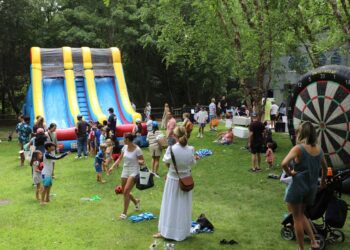Water quality across the East End has been a topic of interest for many years now.
On Friday, May 22, a real-time water quality buoy was installed at the northern end of Lake Agawam Park in Southampton Village by the Lake Agawam Conservancy. The project, which is spearheaded by the Gobler Lab at Stony Brook University’s School of Marine & Atmospheric Sciences, will provide data on the levels of blue-green algae, other algae, temperature, dissolved oxygen, pH, and nitrate. The results will be reported in real-time on the Conservancy’s website.
“Lake Agawam is one of the most polluted lakes in our State,” said Dr. Christopher Gobler, the Conservancy’s Science Advisor. “This buoy will allow us to monitor and report, in real-time, changes in the ecological parameters of the Lake. Some of these changes have a direct effect on the water quality of the Lake, including harmful algal blooms. A similar buoy has been used successfully in Georgica Pond to monitor its water quality in real-time.” The detection of rapid changes in the levels of blue-green algae or dissolved oxygen will be used to initiate intense monitoring or mitigation approaches.”
The installation and maintenance costs will be covered by The Conservancy, which was founded in August 2019 by concerned residents of Southampton Village. The non-profit’s mission “is to cleanse and preserve Lake Agawam and its surrounding ecosystem for the sake of public health and civic enjoyment of a shared natural resource.”
Last fall, Governor Andrew Cuomo visited the Lake and pledged his support. The DEC, Southampton Village and Town officials, and the Governor have been working on a comprehensive plan to remediate Lake Agawam.
“The Conservancy is delighted to partner with Governor Cuomo, the State Department of Environmental Conservation (DEC), Mayor Warren, Supervisor Schneiderman, and Southampton Village and Town Trustees on the installation and maintenance of this buoy,” added Meghan Nadosy Magyar, a member of the Conservancy’s Board. “This buoy is an important first step in the process of remediating the Lake. The public can now monitor daily changes in the health of Lake Agawam. We are so fortunate that Dr. Gobler, the expert on Lake Agawam, is providing the science to support our efforts.”
The Conservancy has also been focused on environmentally friendly landscaping practices, offering programs for local landscapers and homeowners, as well as reducing the number of water lilies that create high levels of toxins around the Lake.
The Conservancy has several projects in place that will be carried out over the next few months to improve the Lake’s water quality in the short-term, such as installing over 40 aerators around the Lake and funding the installation of a bioswale along the southern end of the Lake. They also joined forces with the Village to better protocols for opening the drain pipe between the Lake and the ocean.
For more information, visit lakeagawam.org.






